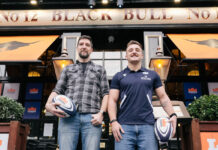Low and no-alcohol is no longer just for designated drivers, say firms

HEALTH and wellbeing are likely to be in the spotlight more this month than at any other time of the year – whether through new year resolutions or initiatives such as Dry January.
But that doesn’t mean healthier food and drink are only worth stocking in January.
Suppliers and brand owners told SLTN that demand for healthier options in the on-trade – whether that is lower-calorie food or drink, low or no-alcohol drinks or all of the above – has been increasing steadily as consumption habits change.
As Dan Harwood of Halewood Wines & Spirits, parent company of Eisberg alcohol-free wine, said: what was “previously seen as something only for designated drivers or pregnant women has now developed into a popular lifestyle choice”.
“The public demand a full range of alcohol-free drinks with a premium feel, but that do not have a negative impact on their waistlines,” said Harwood.
Rosie Crossman, brand manager for Franklin & Sons at parent company Global Brands, said the general public is more calorie-conscious now than ever before.
“Consumers are more likely to choose low or no options when dining out, and 40% of consumers say they use calorie content to determine their choice of drink, making these options an important range for venues,” said Crossman.
And although the younger, ‘Instagram generation’ is said to be at the forefront of the healthier living trend, young consumers aren’t the only ones embracing healthier food and drink.
Jerry Shedden, category and trade marketing director at Heineken, said around half of consumers are now moderating their alcohol intake, with 67% trying to lead a healthy lifestyle.
And while 18 to 24 year-olds might be leading the charge, Shedden said “moderation spans all ages and it’s not just teetotallers that are grabbing for the ‘low and no’ options”.
“When looking at demographic breakdown, 37% of 18 to 34 year olds say they have purchased a non-alcoholic beer in the on-trade over the past six months, whilst an equal 37% of 35 to 54 year olds have done the same and 26% of 55-plus year olds,” said Shedden.
As demand has increased so has the number of products on the market and in 2020 there is a wide range of wines, beers and spirits that fit into the ‘low and no’ category.
One of the first things to consider when putting together a range is understanding the category itself, according to Jason Clarke of Genius Brewing.
He said that different products appeal to different consumers at different times and so it is “vital to understand the difference between ‘low’ and ‘no’ alcohol as they are very different propositions”.
“‘No-alcohol’ products cater to those customers who don’t want alcohol: the teetotal; the drivers; and those going ‘dry’,” said Clarke.
“This is a growing market.
“However, the majority of customers still want some ‘booze’, just less.
“That is why ‘lower-alcohol’ is such an important distinction with growing demand.”
It’s fine to test the water before you jump in, and Morgenrot sales director, Graham Archibald advised operators against going for a keg of low or no-alcohol beer right away.
“When a draught keg is opened and doesn’t sell quick enough, its taste quality will decrease so operators need to ensure they have the customers,” said Archibald.
“I would recommend starting with a creative packaged range and only look at draught options when you are certain of the volume.
“With the incredible array of packaged options now available, there are plenty of ways to drive trial, impress consumers and increase volume.”
As with any new offer, there are some standard steps to establishing a healthier or low and no range, according to Paul Hunter, soft drinks category buyer at Star Pubs & Bars.
He said there are “three cornerstones” to establishing any new offer in a venue: ranging, visibility and quality of serve.
“In terms of ranging, stocking a broad range of flavours, including low calorie options and premium variants, will appeal to the widest market,” said Hunter.
“Visibility is absolutely crucial – you can stock the best range in the world, but unless customers are aware of the products that are available via menus, POS materials and, vitally, staff advocacy, your sales will struggle.
“Be proud of your offer and give it a voice.
“Finally, the quality of the serve is incredibly important – going alcohol-free should in no way indicate a drop-off in quality or the desire for a premium experience coupled with first class service.
“Get the range, visibility and quality right and you’re on to a winner.”
Ultimately, demand for healthier products in the on-trade is only expected to go up, and Alex Carlton of Elegantly Spirited, the firm behind zero-ABV spirit Stryyk, said Dry January is likely to be “just the beginning”.
“It’s therefore crucial that operators adapt their offering to keep these customers happy and in outlet for longer,” said Carlton.



















